04-09软件设计师专业英语真题译文及答案
软件工程专业英语考试翻译

TranslationUnit-1III. (1) 由于计算机与信息系统的结合以及复杂的图形用户界面而产生的新技术对软件工程师提出了新的要求。
(2) 不同类型系统和使用这些系统的不同类型组织的广泛的多样性,意味着我们需要软件开发方法的多样性。
…………………. 第8页翻译III. (1) 当芯片设计者为微处理器开发各种各样的指令集的同时,他们增加了越来越复杂的指令,每个指令的执行都需要若干时钟周期。
………………………..第13页翻译Unit-2III. (1) 对于详细说明软件需求中的困难,根本原因源于其涉及客户、最终用户、以及软件开发人员的有关三方.。
第22页翻译III. (1) 正如我们所知,指示一台计算机如何执行一项任务的指令被称为计算机程序。
(2) 这类软件包含大量数据——不像数据库软件,数据库软件销售时不带任何数据。
…………………………….第27页翻译Unit-3III. (1) 为了即使在风险存在的情况下能够达到项目目标,需要适当的风险管理。
(2) 通过适当的监控,这些情况能够被识别,从而可以相应地改变计划。
………………………………….第38页翻译III. (1) 不过,主要区别在于,多用户操作系统排定在一个集中式计算机上的处理请求,而网络操作系统仅仅是将数据和程序路由到每个用户的本地计算机,实际处理是发生在每个用户的本地计算机上。
……………………….第42页翻译Unit-4III. (1) 详细进度安排只有在实际的人员分配已经完成之后才进行,因为任务分配需要团队成员能力的相关信息。
(2) 小组目标由全体成员的一致同意来设定,并且每位成员的提议可用于重要决定。
…………………………………………….第52页翻译III. (1) 以太网是一种可用于几乎所有类型的计算机,描述数据如何能够在计算机与通常在近距离的其它网络设备之间以包的形式发送的局域网技术。
…………………第58页翻译Unit-5III. (1) 以数据结构为中心的设计(例如,Jackson方法,Warnier-Orr方法)从程序操作的数据结构着手,而不是从其实现的功能着手。
软件设计师试题答案
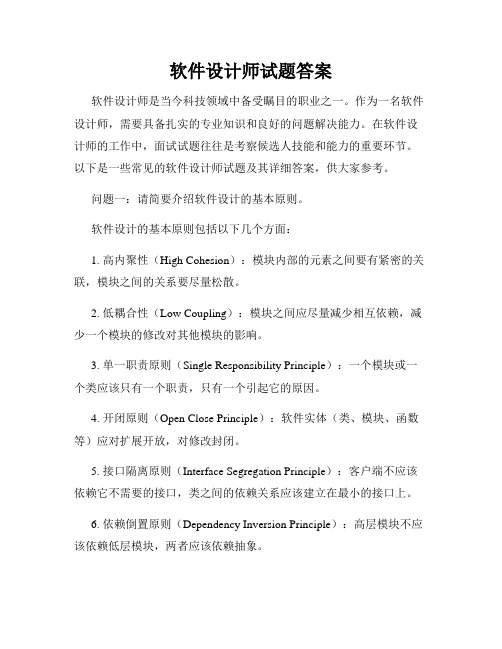
软件设计师试题答案软件设计师是当今科技领域中备受瞩目的职业之一。
作为一名软件设计师,需要具备扎实的专业知识和良好的问题解决能力。
在软件设计师的工作中,面试试题往往是考察候选人技能和能力的重要环节。
以下是一些常见的软件设计师试题及其详细答案,供大家参考。
问题一:请简要介绍软件设计的基本原则。
软件设计的基本原则包括以下几个方面:1. 高内聚性(High Cohesion):模块内部的元素之间要有紧密的关联,模块之间的关系要尽量松散。
2. 低耦合性(Low Coupling):模块之间应尽量减少相互依赖,减少一个模块的修改对其他模块的影响。
3. 单一职责原则(Single Responsibility Principle):一个模块或一个类应该只有一个职责,只有一个引起它的原因。
4. 开闭原则(Open Close Principle):软件实体(类、模块、函数等)应对扩展开放,对修改封闭。
5. 接口隔离原则(Interface Segregation Principle):客户端不应该依赖它不需要的接口,类之间的依赖关系应该建立在最小的接口上。
6. 依赖倒置原则(Dependency Inversion Principle):高层模块不应该依赖低层模块,两者应该依赖抽象。
问题二:请解释什么是面向对象的设计(Object-Oriented Design),并提供一个实例说明。
面向对象的设计是一种以对象为基础进行系统开发的方法。
面向对象的设计主要包括以下几个特点:1. 封装(Encapsulation):将数据(属性)和操作(方法)封装在一个对象内部,对象的内部实现细节对外部是不可见的。
2. 继承(Inheritance):通过继承机制实现代码的复用,子类可以继承父类的属性和方法,并可以进行扩展和重写。
3. 多态(Polymorphism):同一个方法可以根据不同的对象调用产生不同的行为结果,提高代码的灵活性和可扩展性。
计算机专业英语翻译及课后答案
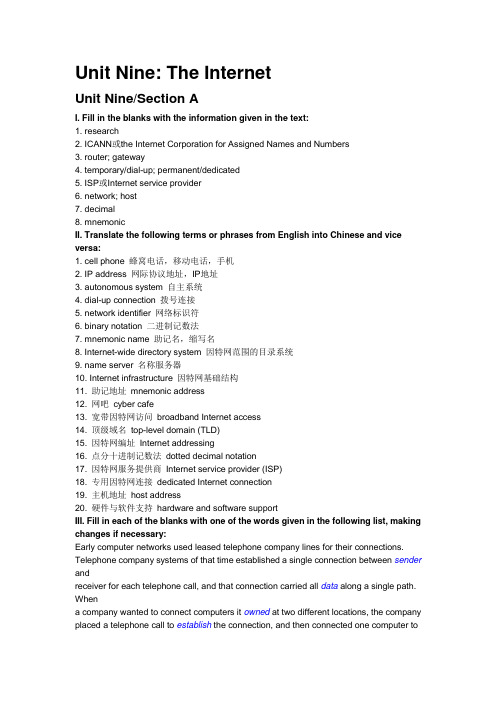
Unit Nine: The InternetUnit Nine/Section AI. Fill in the blanks with the information given in the text:1. research2. ICANN或the Internet Corporation for Assigned Names and Numbers3. router; gateway4. temporary/dial-up; permanent/dedicated5. ISP或Internet service provider6. network; host7. decimal8. mnemonicII. Translate the following terms or phrases from English into Chinese and vice versa:1. cell phone 蜂窝电话,移动电话,手机2. IP address 网际协议地址,IP地址3. autonomous system 自主系统4. dial-up connection 拨号连接5. network identifier 网络标识符6. binary notation 二进制记数法7. mnemonic name 助记名,缩写名8. Internet-wide directory system 因特网范围的目录系统9. name server 名称服务器10. Internet infrastructure 因特网基础结构11. 助记地址mnemonic address12. 网吧cyber cafe13. 宽带因特网访问broadband Internet access14. 顶级域名top-level domain (TLD)15. 因特网编址Internet addressing16. 点分十进制记数法dotted decimal notation17. 因特网服务提供商Internet service provider (ISP)18. 专用因特网连接dedicated Internet connection19. 主机地址host address20. 硬件与软件支持hardware and software supportIII. Fill in each of the blanks with one of the words given in the following list, making changes if necessary:Early computer networks used leased telephone company lines for their connections. Telephone company systems of that time established a single connection between sender andreceiver for each telephone call, and that connection carried all data along a single path. Whena company wanted to connect computers it owned at two different locations, the company placed a telephone call to establish the connection, and then connected one computer toeachend of that single connection.The U. S. Defense Department was concerned about the inherent risk of thissingle-channel method for connecting computers, and its researchers developed a differentmethod of sending information through multiple channels. In this method, files and messagesare broken into packets that are labeled electronically with codes for their origins, sequences,and destinations. In 1969, Defense Department researchers in the Advanced Research ProjectsAgency (ARPA) used this network model to connect four computers into a network called theARPANET. The ARPANET was the earliest of the networks that eventually combined to become what we now call the Internet. Throughout the 1970s and 1980s, many researchers inthe academic community connected to the ARPANET and contributed to the technological developments that increased its speed and efficiency.IV. Translate the following passage from English into Chinese:因特网只是提供了将许许多多的计算机连接在一起的物理与逻辑基础结构。
04-09程序员专业英语真题译文及答案
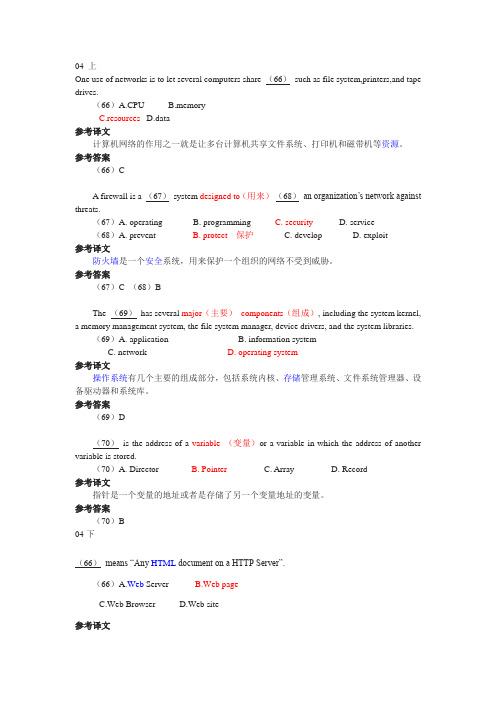
04 上One use of networks is to let several computers share (66)such as file system,printers,and tape drives.(66)A.CPU B.memoryC.resourcesD.data参考译文计算机网络的作用之一就是让多台计算机共享文件系统、打印机和磁带机等资源。
参考答案(66)CA firewall is a (67)system designed to(用来)(68)an organization’s network against threats.(67)A. operating B. programming C. security D. service(68)A. prevent B. protect保护 C. develop D. exploit参考译文防火墙是一个安全系统,用来保护一个组织的网络不受到威胁。
参考答案(67)C (68)BThe (69)has several major(主要)components(组成), including the system kernel, a memory management system, the file system manager, device drivers, and the system libraries.(69)A. application B. information systemC. networkD. operating system参考译文操作系统有几个主要的组成部分,包括系统内核、存储管理系统、文件系统管理器、设备驱动器和系统库。
参考答案(69)D(70)is the address of a variable (变量)or a variable in which the address of another variable is stored.(70)A. Director B. Pointer C. Array D. Record参考译文指针是一个变量的地址或者是存储了另一个变量地址的变量。
计算机专业英语试题含答案
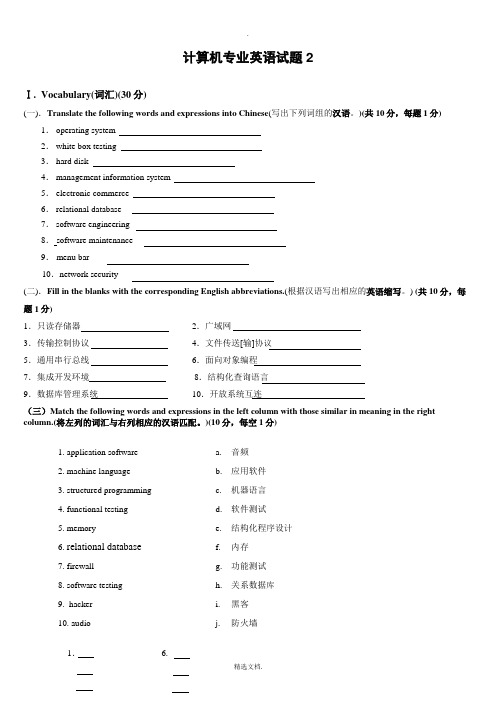
计算机专业英语试题2Ⅰ. Vocabulary(词汇)(30分)(一).Translate the following words and expressions into Chinese(写出下列词组的汉语。
)(共10分,每题1分)1.operating system2.white box testing3.hard disk4.management information system5.electronic commerce6.relational database7.software engineering8. software maintenance9. menu bar10.network security(二).Fill in the blanks with the corresponding English abbreviations.(根据汉语写出相应的英语缩写。
) (共10分,每题1分)1.只读存储器 2.广域网3.传输控制协议 4.文件传送[输]协议5.通用串行总线 6.面向对象编程7.集成开发环境 8.结构化查询语言9.数据库管理系统 10.开放系统互连(三)Match the following words and expressions in the left column with those similar in meaning in the right column.(将左列的词汇与右列相应的汉语匹配。
)(10分,每空1分)1. application software a. 音频2. machine language b. 应用软件3. structured programming c. 机器语言4. functional testing d. 软件测试5. memory e. 结构化程序设计6. relational database f. 内存7. firewall g. 功能测试8. software testing h. 关系数据库9. hacker i. 黑客10. audio j. 防火墙1. 6.2. 7.3. 8.4. 9.5. 10.Ⅱ. Comprehension(阅读理解)(一)Fill in the blanks with suitable words or expressions from the list given below, and change the form wherenecessary. (从下面方框中选择合适的词或表达,以其适当的形式填空。
软件水平考试《软件设计师》历年真题及答案汇总
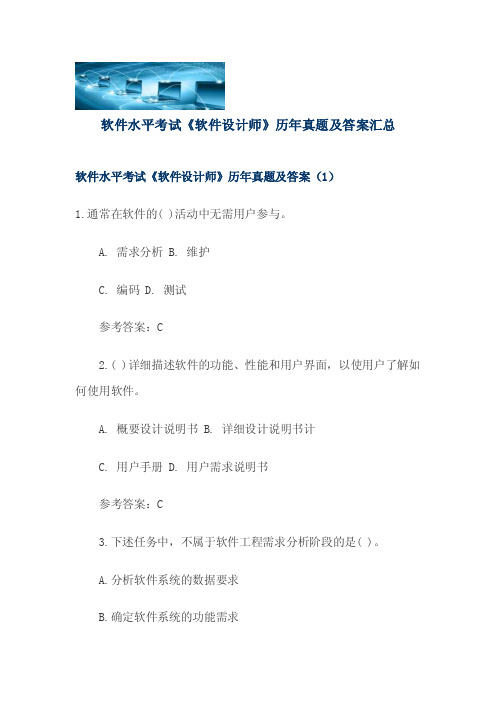
软件水平考试《软件设计师》历年真题及答案汇总软件水平考试《软件设计师》历年真题及答案(1)1.通常在软件的( )活动中无需用户参与。
A. 需求分析B. 维护C. 编码D. 测试参考答案:C2.( )详细描述软件的功能、性能和用户界面,以使用户了解如何使用软件。
A. 概要设计说明书B. 详细设计说明书计C. 用户手册D. 用户需求说明书参考答案:C3.下述任务中,不属于软件工程需求分析阶段的是( )。
A.分析软件系统的数据要求B.确定软件系统的功能需求C.确定软件系统的性能要求D.确定软件系统的运行平台参考答案:D4.在开发信息系统时,用于系统开发人员与项目管理人员沟通的主要文档是( )。
A. 系统开发合同B. 系统设计说明书C. 系统开发计划D. 系统测试报告参考答案:B5.系统测试人员与系统开发人员需要通过文档进行沟通,系统测试人员应根据一系列文档对系统进行测试,然后将工作结果撰写成( ),交给系统开发人员。
A. 系统开发合同B. 系统设计说明书C. 测试计划D. 系统测试报告参考答案:D6.常见的软件开发模型有瀑布模型、演化模型、螺旋模型、喷泉模型等。
其中( )模型适用于需求明确或很少变更的项目,( )模型主要用来描述面向对象的软件开发过程。
A.瀑布模型B.演化模型C.螺旋模型D.喷泉模型参考答案:A、D7.在开发一个系统时,如果用户对系统的目标是不很清楚,难以定义需求,这时最好使用( )。
A.原型法瀑布模型 C.V-模型 D.螺旋模型参考答案:A8.采用瀑布模型进行系统开发的过程中,每个阶段都会产生不同的文档。
以下关于产生这些文档的描述中,正确的是( )。
A.外部设计评审报告在概要设计阶段产生。
B.集成测评计划在程序设计阶段产生。
C.系统计划和需求说明在详细设计阶段产生。
D.在进行编码的同时,独立的设计单元测试计划参考答案:D9.( )是一种面向数据流的开发方法,其基本思想是软件功能的分解和抽象。
(完整)软件工程专业英语
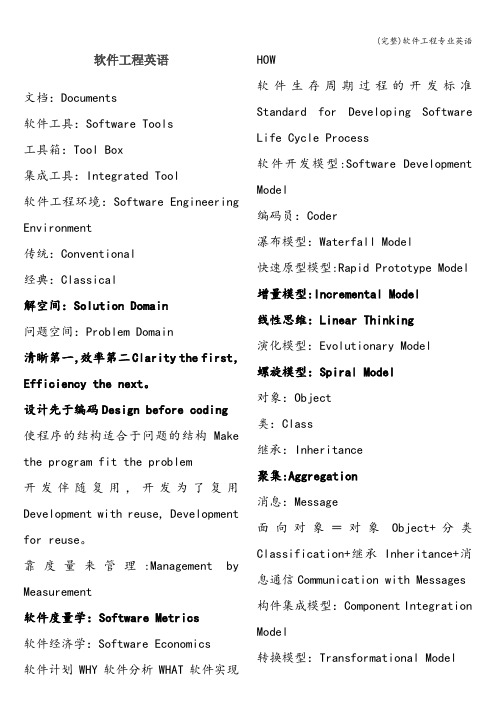
软件工程英语文档:Documents软件工具:Software Tools工具箱:Tool Box集成工具:Integrated Tool软件工程环境:Software Engineering Environment传统:Conventional经典:Classical解空间:Solution Domain问题空间:Problem Domain清晰第一,效率第二Clarity the first,Efficiency the next。
设计先于编码Design before coding使程序的结构适合于问题的结构Make the program fit the problem开发伴随复用,开发为了复用Development with reuse, Development for reuse。
靠度量来管理:Management by Measurement软件度量学:Software Metrics软件经济学:Software Economics软件计划WHY软件分析WHAT软件实现HOW软件生存周期过程的开发标准Standard for Developing Software Life Cycle Process软件开发模型:Software Development Model编码员:Coder瀑布模型:Waterfall Model快速原型模型:Rapid Prototype Model 增量模型:Incremental Model线性思维:Linear Thinking演化模型:Evolutionary Model螺旋模型:Spiral Model对象:Object类:Class继承:Inheritance聚集:Aggregation消息:Message面向对象=对象Object+分类Classification+继承Inheritance+消息通信Communication with Messages 构件集成模型:Component Integration Model转换模型:Transformational Model净室软件工程:Cleanroom Software Engineering净室模型:Cleanroom Model软件需求规格说明书:Software Requirement Specification ,SRS分析模型:Analysis Model便利的应用规约技术:Facilitated Application Specification Techniques ,FAST结构化语言:Structured Language判定树:Decision Tree基数:Cardinality事件轨迹:Event Trace对象-关系Object—Relationsship结构化分析:SA(Structured Analysis)由顶向下,逐步细化Top-Down Stepwise Refinement面向对象分析:Object-Oriented Analysis包含:Contains临近:Is Next To传到:Transmits to来自:Acquires from管理:Manages 控制:Controls组成:Is Composed of细化:Refinement抽象:Abstraction模块:Module策略:Strategy信息隐藏:Information Hiding数据封装:Data Encapsulation抽象数据类型:Abstract Data type模块化设计:Modular Design分解:Decomposition模块性:Modularity单模块软件:Monolithic Software模块独立性:Module Independence内聚:Cohesion偶然性内聚:Coincidental Cohesion逻辑性内聚:Logical Cohesion时间性内聚:Temporal Cohesion过程性内聚: Procedural Cohesion通信性内聚:Communicational Cohesion顺序性内聚:Sequential Cohesion功能性内聚:Functional Cohesion非直接偶合:No Direct Coupling数据偶合:Data Coupling特征偶合:Stamp Coupling控制偶合:Control Coupling外部偶合:External Coupling公共偶合:Common Coupling内容偶合: Content Coupling由底向上设计:Bottom-Up Design自顶向下设计:Top-Down Design正式复审:Formal Review非正式复审:Informal Review走查,排练:Walk-Through会审:Inspection映射:Mapping传入路径:Afferent path传出路径:Efferent path变换中心:Transform Center接受路径:Reception path动作路径:Action path事务中心:Transaction Center分支分解:Factoring of Brandches瓮形:oval-shaped一个模块的控制域:Scope of Control 一个模块的作用域:Scope of Effect 结构化程序设计:Structured Programming通心面程序:Bowl of Spaghetti流程图:Flow Diagram编码:Coding方框图:Block DiagramPDL (Pidgin):Program Design Language伪代码:Pseudo CodeJSD:Jackson System Development对象建模技术:Object Modeling Technique基础设施:Infrastructure控制线程:Thread of Control保护者对象:Guardian Object协议:protocolUML:Unified Modeling Language OMG:Object Management Group统一方法:Unified Method关联:Association泛化:Generalization依赖:Dependency结点:Node接口:Interface包:Package注释: Note特化:Specialization元元模型:Meta—Meta Model用户模型:User Model静态图:Static Diagram动态图:Dynamic Diagram用例视图:Use Case View逻辑视图:Logical View并发视图:Concurrent View构件视图:Component View实现模型视图:Implementation Model View部署视图:Deployment View航向:Navigability重数:Multiplicity共享聚集:Shared Aggregation组合:Composition泛化:Generalization简单消息:Simple Message同步消息:Synchronous Message异步消息:Asynchronous Message事件说明:Event_Signature守卫条件:Guard_Condition动作表达式:Action_Expression 发送子句:Send_Clause时序图:Sequence Diagram协作图:Collaboration Diagram前缀:Predecessor循环子句:Iteration-Clause活动图:Activity Diagram构件图:Component Diagram配置图:Deployment Diagram建模过程指导(RUP):Rational Unified Process可执行代码:Executalbe Codes实现:Implementation编码风格:Coding Style标准:Classical控制流的直线性:Linearity of Control Flow程序风格设计要素:先求正确后求快 Make it right before you make it faster.先求清楚后求快 Make it clear before you make it faster.求快不忘保持程序正确 Keep it right when you make it faster.保持程序简单以求快 Keep it simpleto make it faster。
程序员专业英语真题译文及答案
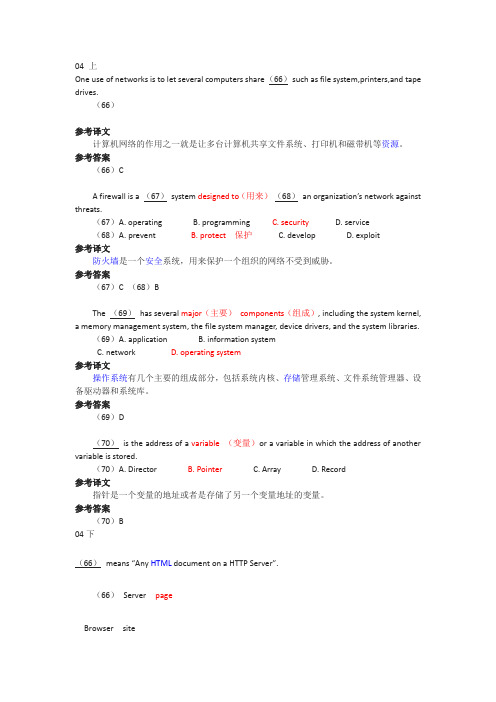
04 上One use of networks is to let several computers share (66)such as file system,printers,and tape drives.(66)参考译文计算机网络的作用之一就是让多台计算机共享文件系统、打印机和磁带机等资源。
参考答案(66)CA firewall is a (67)system designed to(用来)(68)an organization’s networ k against threats.(67)A. operating B. programming C. security D. service(68)A. prevent B. protect保护 C. develop D. exploit参考译文防火墙是一个安全系统,用来保护一个组织的网络不受到威胁。
参考答案(67)C (68)BThe (69)has several major(主要)components(组成), including the system kernel, a memory management system, the file system manager, device drivers, and the system libraries.(69)A. application B. information systemC. networkD. operating system参考译文操作系统有几个主要的组成部分,包括系统内核、存储管理系统、文件系统管理器、设备驱动器和系统库。
参考答案(69)D(70)is the address of a variable (变量)or a variable in which the address of another variable is stored.(70)A. Director B. Pointer C. Array D. Record参考译文指针是一个变量的地址或者是存储了另一个变量地址的变量。
软件工程师考题-中英文
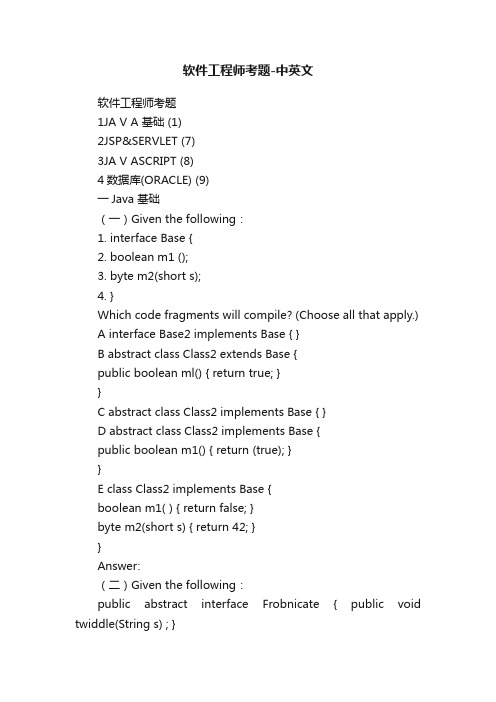
软件工程师考题-中英文软件工程师考题1JA V A 基础 (1)2JSP&SERVLET (7)3JA V ASCRIPT (8)4数据库(ORACLE) (9)一Java 基础(一)Given the following:1. interface Base {2. boolean m1 ();3. byte m2(short s);4. }Which code fragments will compile? (Choose all that apply.)A interface Base2 implements Base { }B abstract class Class2 extends Base {public boolean ml() { return true; }}C abstract class Class2 implements Base { }D abstract class Class2 implements Base {public boolean m1() { return (true); }}E class Class2 implements Base {boolean m1( ) { return false; }byte m2(short s) { return 42; }}Answer:(二)Given the following:public abstract interface Frobnicate { public void twiddle(String s) ; }Which is a correct class? (Choose all that apply.)A public abstract class Frob implements Frobnicate {public abstract void twiddle(String s){}}B public abstract class Frob implements Frobnicate { }C public class Frob extends Frobnicate {public void twiddle(Integer i) { }}D public class Frob implements Frobnicate {public void twiddle(Integer i) { }}E public class Frob implements Frobnicate {public void twiddle(String i) { }public void twiddle(Integer s) { }}Answer:(三)Given the following:1. class Plant {2. String getName() { return "plant"; }3. Plant getType() { return this; }4. }5. class Flower extends Plant {6. // insert code here7. }8. class Tulip extends Flower {}Which statement(s), inserted at line 6, will compile? (Choose all that apply.)A Flower getType() { return this; }B String getType() { return "this"; }C Plant getType() { return this; }D Tulip getType() { return new Tulip() ;}Answer:(四)Given the following:class Clidder {private final void flipper() { System.out.println ("Clidder"); } }public class Clidlet extends Clidder {public final void flipper() { System.out.println("Clidlet"); } public static void main(String [] args) {new Clidlet().flipper();}}What is the result?A ClidletB ClidderC ClidderClidletD ClidletClidderE Compilation fails.Answer:(五)Given the following,class Knowing {static final long tooth = 343L;static long doIt(long tooth) {System.out.print(++tooth + " ");return ++tooth;}public static void main(String[] args) {System.out.print(tooth + " ");final long tooth = 340L;new Knowing().doIt(tooth);System.out.println(tooth);}}What is the result?A 343 340 340B 343 340 342C 343 341 342D 343 341 340E 343 341 343F Compilation fails.G An exception is thrown at runtimeAnswer:(六)Given the following,1. class Bigger {2. public static void main(String[] args) {3. // insert code here4. }5. }6. class Better {7. enum Faster {Higher, Longer};8. }Which, inserted independently at line 3, will compile? (Choose all that apply.)A Faster f = Faster.Higher;B Faster f = Better.Faster.Higher;C Better.Faster f = Better.Faster.Higher;D Bigger.Faster f = Bigger.Faster.Higher;E Better. Faster f2; f2 = Better.Faster.Longer;F Better b; b.Faster = f3; f3 = Better.Faster.Longer;Answer:(七)Given the following,import java.io.*;class Master {String doFileStuff() throws FileNotFoundException { return "a"; }}class Slave extends Master {public static void main(String[] args) {String s = null;try { s = new Slave().doFileStuff();} catch ( Exception x) {s = "b"; }System.out.println(s);}// insert code here}Which, inserted independently at // insert code here, will compile, and produce the output b? (Choose all that apply.)A String doFileStuff() { return "b"; }B String doFileStuff() throws IOException ( return "b"; }C String doFileStuff(int. x) throws IOException ( return "b"; }D String doFileStuff() throws FileNotFoundException { return "b"; }E String doFileStuff() throws NumberFormatException { return "b"; }F String doFileStuff() throws NumberFormatException, FileNotFoundException { return "b"; }Answer:(八)Given the following,class Swill {public static void main(String[] args) { String s = "-";switch(TimeZone.CST) {case EST: s += "e";case CST: s += "c";case MST: s += "m";default: s += "X";case PST: s += "p";}System.out.println(s);}}enum TimeZone {EST, CST, MST, PST } What is the result?A -cB -XC -cmD -cmpE -cmXpF Compilation fails.G An exception is thrown at runtime. Answer:(九)Given the following1. import java.text.DateFormat;2. import java.util.Calendar;3. class DateOne {4. public static void main(String[] args) {5. Calendar d = new Calendar();6. DateFormat df = DateFormat.getInstance();7. System.out.println(df.format(d.getTime()));8. }9. }What is the result?A 09-8-5 下午3:48B 1123631685981L,C An exception is thrown at runtime.D Compilation fails due to a single error in the code.E Compilation fails due to multiple errors in the code.Answer:(十)Given the following,import java.io.*;class Player {Player() { System.out.print("p"); }}class CardPlayer extends Player implements Serializable { CardPlayer() { System.out.print("c"); }public static void main(String[] args){CardPlayer cl = new CardPlayer();try {FileOutputStream fos = new FileOutputStream("play.txt");ObjectOutputStream os = new ObjectOutputStream(fos);os.writeObject(c1);os.close() ;FileInputStream fis = new FileInputStream("play.txt");ObjectInputStream is = new ObjectInputStream(fis);CardPlayer c2 = (CardPlayer) is.readObject();is.close();} catch (Exception x ) { }}}What is the result?A pcB pccC pcpD pcpcE Compilation fails.F An exception is thrown at runtime. Answer:(十一)Given the following,class Polish {public static void main(String[] args) {int x = 4 ;StringBuffer buff = new StringBuffer("..fedcba"); buff.delete(3,6);buff.insert(3, "az");if(buff.length() > 6) x = buff.indexOf("b"); buff.delete((x-3), (x-2));System.out.println(buff);} }What is the result?A .fazaB .fzbaC ..azbaD .fazbaE ..fezbaF Compilation fails.F An exception is thrown at runtime. Answer:(十二)Given the following,1.class Master {2. public static void main(String[] args) {3. try{4. System.out.print("1");5. if(true){6. throw new Exception("error");7. }8. System.out.print("2");9. return ;10. }catch(Exception e){11. System.out.print("3");12. }finally{13. System.out.print("4");14. }15. }16. }what is the result?A 1234B 143C 134D 1432E Compilation fails due to a single error in the code. Answer: (十三)是否可以继承String类?Answer:(十四)启动一个线程是用run()还是start()?Answer:(十五)abstract class和interface有什么区别?Answer:(十六)HashMap和Hashtable的区别。
软件设计师历年英语题汇总doc
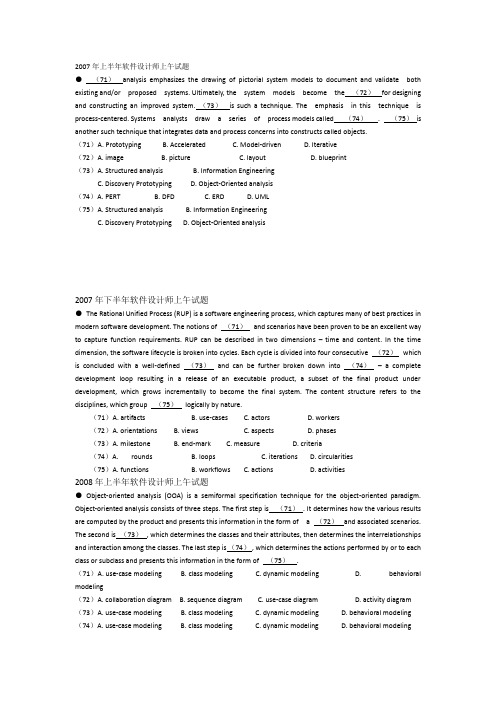
2007年上半年软件设计师上午试题●(71)analysis emphasizes the drawing of pictorial system models to document and validate both existing and/or proposed systems. Ultimately, the system models become the (72)for designing and constructing an improved system. (73)is such a technique. The emphasis in this technique is process-centered. Systems analysts draw a series of process models called (74). (75)is another such technique that integrates data and process concerns into constructs called objects.(71)A. Prototyping B. Accelerated C. Model-driven D. Iterative(72)A. image B. picture C. layout D. blueprint(73)A. Structured analysis B. Information EngineeringC. Discovery PrototypingD. Object-Oriented analysis(74)A. PERT B. DFD C. ERD D. UML(75)A. Structured analysis B. Information EngineeringC. Discovery PrototypingD. Object-Oriented analysis2007年下半年软件设计师上午试题●The Rational Unified Process (RUP) is a software engineering process, which captures many of best practices in modern software development. The notions of (71)and scenarios have been proven to be an excellent way to capture function requirements. RUP can be described in two dimensions – time and content. In the time dimension, the software lifecycle is broken into cycles. Each cycle is divided into four consecutive (72)which is concluded with a well-defined (73)and can be further broken down into (74)–a complete development loop resulting in a release of an executable product, a subset of the final product under development, which grows incrementally to become the final system. The content structure refers to the disciplines, which group (75)logically by nature.(71)A. artifacts B. use-cases C. actors D. workers(72)A. orientations B. views C. aspects D. phases(73)A. milestone B. end-mark C. measure D. criteria(74)A. rounds B. loops C. iterations D. circularities(75)A. functions B. workflows C. actions D. activities2008年上半年软件设计师上午试题●Object-oriented analysis (OOA) is a semiformal specification technique for the object-oriented paradigm. Object-oriented analysis consists of three steps. The first step is (71). It determines how the various results are computed by the product and presents this information in the form of a (72)and associated scenarios. The second is (73), which determines the classes and their attributes, then determines the interrelationships and interaction among the classes. The last step is (74), which determines the actions performed by or to each class or subclass and presents this information in the form of (75).(71)A. use-case modeling B. class modeling C. dynamic modeling D. behavioral modeling(72)A. collaboration diagram B. sequence diagram C. use-case diagram D. activity diagram (73)A. use-case modeling B. class modeling C. dynamic modeling D. behavioral modeling (74)A. use-case modeling B. class modeling C. dynamic modeling D. behavioral modeling(75)A. activity diagram B. component diagram C. sequence diagram D. state diagram2008年下半年软件设计师上午试题●It should go without saying that the focus of UML is modeling. However, what that means, exactly, can be an open-ended question. (71)is a means to capture ideas, relationships,decisions, and requirements in a well-defined notation that can be applied to many different domains. Modeling not only means different things to different people, but also it can use different pieces of UML depending on what you are trying to convey. In general, a UML model is made up of one or more (72). A diagram graphically represents things, and the relationships between these things. These (73)can be representations of real-world objects, pure software constructs, or a description of the behavior of some other objects. It is common for an individual thing to show up on multiple diagrams; each diagram represents a particular interest, or view, of the thing being modeled. UML 2.0 divides diagrams into two categories: structural diagrams and behavioral diagrams. (74 )are used to capture the physical organization of the things in your system, i.e., how one object relates to another. (75)focus on the behavior of elements in a system. For example, you can use behavioral diagrams to capture requirements, operations, and internal state changes for elements.(71)A.Programming B. Analyzing C. Designing D. Modeling(72)A.views B. diagrams C. user views D. structure pictures(73)A. things B. pictures C. languages D. diagrams(74)A. Activity diagrams B. Use-case diagrams C. Structural diagrams D. Behavioral diagrams (75)A. Activity diagrams B. Use-case diagrams C. Structural diagrams D. Behavioral diagrams2009年上半年软件设计师上午试题●For nearly ten years, the Unified Modeling Language (UML) has been the industry standard for visualizing, specifying, constructing, and documenting the (71)of a oftware-intensive system. As the (72)standard modeling language, the UML facilitates ommunication and reduces confusion among project (73). The recent standardization of UML 2.0 has further extended the language's scope and viability. Its inherent expressiveness allows users to (74)everything from enterprise information systems and distributed Web-based applications to real-time embedded systems. The UML is not limited to modeling software. In fact, it is expressive enough to model (75)systems, such as workflow in the legal system, the structure and behavior of a patient healthcare system, software engineering in aircraft combat systems, and the design of hardware.To understand the UML, you need to form a conceptual model of the language, and this requires learning three major elements: the UML's basic building blocks, the rules that dictate how those building blocks may be put together, and some common mechanisms that apply throughout the UML.(71)A. classes B. components C. sequences D. artifacts(72)A. real B. legal C. de facto D. illegal(73)A. investors B. developers C. designers D. stakeholders(74)A. model B. code C. test D. modify(75)A. non-hardware B. non-software C. hardware D. software2009年下半年软件设计师上午试题●Why is (71)fun? What delights may its practitioner expect as his reward? First is the sheer joy of making things. As the child delights in his mud pie, so the adult enjoys building things, especially things of his own design. Second is the pleasure of making things that are useful to other people. Thirdis the fascination of fashioning complex puzzle-like objects of interlocking moving parts and watching them work in subtle cycles, playing out the consequences of principles built in from the beginning. Fourth is the joy of always learning, which springs from the (72)nature of the task. In one way or another the problem is ever new, and its solver learns something: sometimes (73), sometimes theoretical, and sometimesboth. Finally, there is the delight of working in such a tractable medium. The (74), like the poet, works only slightly removed from pure thought-stuff. Few media of creation are so flexible, so easy to polish and rework, so readily capable of realizing grand conceptual structures. Yet the program (75), unlike the poet's words, is real in the sense that it moves andworks, producing visible outputs separate from the construct itself. It prints results, draws pictures, produces sounds, moves arms. Programming then is fun because it gratifies creativelongings built deep within us and delights sensibilities we have in common with all men.(71)A. programming B. composing C. working D. writing(72)A. repeating B. basic C. non-repeating D. advance(73)A. semantic B. practical C. lexical D. syntactical(74)A. poet B. architect C. doctor D. programmer(75)A. construct B. code C. size D. scale2010年上半年软件设计师上午试题● Observe that for the programmer, as for the chef, the urgency of the patron(顾客)may govern the scheduled completion of the task, but it cannot govern the actual completion.An omelette(煎鸡蛋), promised in two minutes, may appear to be progressing nicely. Butwhen it has not set in two minutes, the customer has two choice s―waits or eats it raw.Software customers have had(71)choices.Now I do not think software (72)have less inherent courage and firmness thanchefs, nor than other engineering managers. But false (73)to match the patron's desireddate is much more common in our discipline than elsewhere in engineering. It is very (74)to make a vigorous, plausible, and job risking defense of an estimate that is derived by no quantitative method, supported by little data, and certified chiefly by the hunches of the managers.Clearly two solutions are needed. We need to develop and publicize productivity figures, bug-incidence figures, estimating rules, and so on. The whole profession can only profit from (75)such data. Until estimating is on a sounder basis, individual managers will need to stiffen their backbones and defend their estimates with the assurance that their poor hunches are better than wish derived estimates.(71)A. no B. the same C. other D. lots of(72)A. Testers B. constructors C. managers D. architects(73)A. Tasks B. jobs C. Works D. scheduling(74)A. easy B. difficult C. simple D. painless(75)A. sharing B. excluding C. omitting D. ignoring2010年下半年软件设计师上午试题●People are indulging in an illusion whenever they find themselves explaining at a cocktail(鸡尾酒) party, say, that they are "in computers," or "in telecommunications," or "in electronic funds transfer". The implication is that they are part of the high-tech world. Just between us, they usually aren't. The researchers who made fundamental breakthroughs in those areas are in a high-tech business. The rest of us are (71)of their work. We use computersand other new technology components to develop our products or to organize our affairs. Because we go about this work in teams and projects and other tightly knit working groups(紧密联系在一起的工作小组), we are mostly in the human communication business. Our successes stem from good human interactions by all participants in the effort, and our failures stem from poor human interactions.The main reason we tend to focus on the (72) rather than the human side of the work is not because it's more (73) , but because it's easier to do. Getting the new disk drive installed is positively trivial compared to figuring out why Horace is in a blue funk(恐惧) or why Susan is dissatisfied with the company after only a few months. Human interactions are complicated and never very crisp(干脆的,干净利落的) and clean in their effects, but they matter more than any other aspect of the work.If you find yourself concentrating on the (74) rather than the (75), you're like the vaudeville character(杂耍人物) who loses his keys on a dark street and looks for them on the adjacent street because, as he explains, "The light is better there!".(71)A. creators B. innovators C. appliers D. inventors(72)A. technical B. classical C. socia D. societal(73)A. trivial B. crucial C. minor D. insignificant(74)A. technology B. sociology C. physiology D. astronomy(75)A. technology B. sociology C. physiology D. astronomy2011年上半年软件设计师上午试题。
软件设计师-计算机专业英语(四)
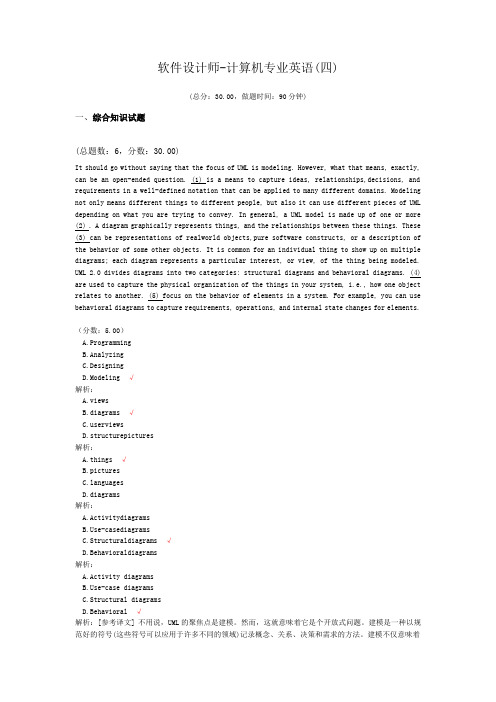
软件设计师-计算机专业英语(四)(总分:30.00,做题时间:90分钟)一、综合知识试题(总题数:6,分数:30.00)It should go without saying that the focus of UML is modeling. However, what that means, exactly, can be an open-ended question. (1) is a means to capture ideas, relationships,decisions, and requirements in a well-defined notation that can be applied to many different domains. Modeling not only means different things to different people, but also it can use different pieces of UML depending on what you are trying to convey. In general, a UML model is made up of one or more(2) . A diagram graphically represents things, and the relationships between these things. These(3) can be representations of realworld objects,pure software constructs, or a description of the behavior of some other objects. It is common for an individual thing to show up on multiple diagrams; each diagram represents a particular interest, or view, of the thing being modeled. UML 2.0 divides diagrams into two categories: structural diagrams and behavioral diagrams. (4) are used to capture the physical organization of the things in your system, i.e., how one object relates to another. (5) focus on the behavior of elements in a system. For example, you can use behavioral diagrams to capture requirements, operations, and internal state changes for elements.(分数:5.00)A.ProgrammingB.AnalyzingC.DesigningD.Modeling √解析:A.viewsB.diagrams √erviewsD.structurepictures解析:A.things √B.picturesnguagesD.diagrams解析:A.Activitydiagramse-casediagramsC.Structuraldiagrams √D.Behavioraldiagrams解析:A.Activity diagramse-case diagramsC.Structural diagramsD.Behavioral √解析:[参考译文] 不用说,UML的聚焦点是建模。
历年(2004-2009)软考专业英语真题、译文及答案
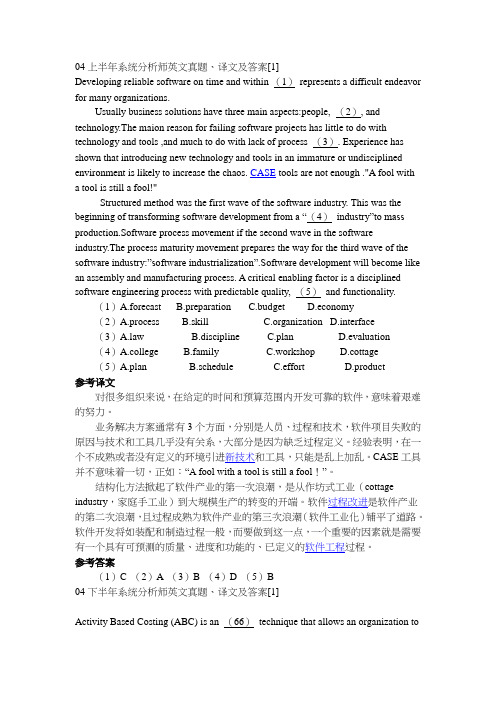
04上半年系统分析师英文真题、译文及答案[1]Developing reliable software on time and within (1)represents a difficult endeavor for many organizations.Usually business solutions have three main aspects:people, (2), and technology.The maion reason for failing software projects has little to do with technology and tools ,and much to do with lack of process (3). Experience has shown that introducing new technology and tools in an immature or undisciplined environment is likely to increase the chaos. CASE tools are not enough ."A fool with a tool is still a fool!"Structured method was the first wave of the software industry. This was the beginning of transforming software development from a “(4)industry”to mass production.Software process movement if the second wave in the software industry.The process maturity movement prepares the way for the third wave of the software industry:”software industrialization”.Software development will become like an assembly and manufacturing process. A critical enabling factor is a disciplined software engineering process with predictable quality, (5)and functionality.(1)A.forecast B.preparation C.budget D.economy(2)A.process B.skill anization D.interface(3)w B.discipline C.plan D.evaluation(4)A.college B.family C.workshop D.cottage(5)A.plan B.schedule C.effort D.product参考译文对很多组织来说,在给定的时间和预算范围内开发可靠的软件,意味着艰难的努力。
计算机专业英语的第四版课后习题翻译

中译英参考答案Unit 1A computer system consists of hardware system and software system. The hardware of the computer is usually divided into three major parts or three primary subsystems: the CPU, the memory subsystem, and the I/O subsystem.The CPU performs many operations and controls computer. The memory subsystem is used to store program being executed by the CPU, along with the program’s data. The I/O subsystem allows the CPU to interact with input and output devices such as the keyboard and monitor of a personal computer. The components of the computer are connected to the buses.The part of the computer that performs the bulk of data processing operations is called the central processing unit and is referred to as the CPU. In microcomputer, it is often called the microprocessor. The CPU is made up of three major parts: control unit, ALU, and register set.Memory is also known as internal memory or main memory. It refers to the circuits in the computer that hold whatever programs and data are available for immediate use by the CPU.I/O subsystem includes I/O devices and interface. There are a wide variety of I/O devices, such as mouse, printer, sensor, disk, and so on. Input-output interface provides a method for transferring information between internal storage and external I/O devices. Peripherals connected to a computer need special communication links for interfacing them with the CPU. The purpose of the communication link is to resolve the differences that exist between the central computer and each peripheral.Unit 2Storage hardware provides permanent storage of information and programs for retrieval by the computer. Hard disk drives store information in magnetic particles embedded in a disk. Usually a permanent part of the computer, hard disk drives can store large amounts of information and retrieve that information very quickly.Although fixed hard drive systems offer faster access and have a higher storage capacity than optical discs, optical disc systems use removable media – a distinct benefit. Optical discs – primary CDs and DVDs – are much more widely used than removable hard drive systems. They are the standard today for software delivery, as well as commonly used for storing high-capacity music and video files. There are also versions of both CD and DVD drives available for home audio and home theater use. Optical discs are commonly referred to as compact discs.CD and DVD discs are read by CD and DVD drives. The speed of a CD or DVD drive is rated as 24x, 32x, 36x, and so on. These labels describe how fast the drive is compared to the first version of that drive. For example, a 36x drive is 36 times the speed of the baseline unit that was originally manufactured.Most optical discs have a title and other text printed only on one side and they are inserted into the drive with the printed side facing up. When inserting such a CD or DVD, be careful not to get dirt, fingerprints, scratches, or anything else that might hinder light reflectivity on the disc’s surface.Unit 3(a) A program is a list of instructions or statements for directing the computer to perform a required data processing task. Programming is a multistep process for creating that list of instructions.(b) It is important to understand the difference between a class and an object of that class. A class is simply a specification for creating objects. Thus, a single class may create multiple objects.(c) Java is an object-oriented, network-friendly high-lever programming language that allows programmers to build applications that can run on almost any operating system.(d) ActiveX is a set of controls, or reusable components that enables programs or content of almost any type to be embedded within a Web page. Whereas a Java must be downloaded each time you visit a Web site, with ActiveX the component is downloaded only once, then stored on your hard disk for later, repeated use.(e) Programming involves a great deal of creativity. The design is guide to the function or purpose of each component, but the programmer has great flexibility in implementing the design as code. No matter what language is used, each program component involves at least three major aspects: control structures, algorithms, and data structures.Unit 4The software system can be divided into two broad categories: application software and system software. Application software consists of the program for performing tasks particular to the machine’s utilization. In contrast to application software, system software comprises a large number of programs. These programs start up the computer and function as the principle coordinator of all hardware components and application software. Without system software loaded into RAM of your computer, your hardware and application software are useless.System software can be grouped into three basic parts: operating system, utility software, and language translators. The majority of an installation’s utility software consists of programs for performing activities that are fundamental to computer installations yet not included in the operating system. In a sense, utility software consists of software units that extend the capabilities of the operating system.A computer’s OS is the main collection of programs that manage its activities.The primary chores of an OS are management and control. The OS ensures that all actions requested by a user are valid and processed in an orderly fashion. It also manages the computer system’s resources to perform these operations with efficiency and consistency.Application software is the software designed to help you solve problems specific to business or perform specific business tasks. Application software then is the layer of software closest to you. Basically, there are four categories of application software: productivity software, business and specialty software, entertainment software and education/reference software.Unit 5A computer network is often classified as being either a local area network (LAN), a metropolitan area network (WAN), or a wide area network (WAN). The connection of two or more networks is called an internetwork. The worldwide Internet is a well-known example of an internetwork.LANs are privately owned networks within a single building or campus of up to a few kilometers in size. They are widely used to connect personal computers and workstations in company offices and factories to share resources and exchange information.In general, a given LAN will use only one type of transmission medium. Various topologies are possible for LANs. The most common LAN topologies are bus, ring and star.A MAN is basically a bigger version of a LAN and normally uses similar technology. MAN is designed to extend over an entire city. It may be a single network such as a cable television network, or it may be a means of connecting a number of LANs into a large network so that resources may be shared LAN-to-LAN as well as device-to-device. For example, a company can use a MAN to connect the LANs in all of its offices throughout a city.A W AN spans a large geographical area that may comprise a country, a continent, or even the world. It provides long-distance transmission of data, voice, image, and video information over large geographical area.In contrast to LANs, W ANs may utilize public leased, or private communication devices, usually in combinations, and can therefore span an unlimited number of miles.Unit 6Transmission media are used to transfer messages over a network. For instance, the transmission media used in a network may be a privately owned set of cables, the public phone lines, or a satellite system. Transmission media can either be wired or wireless.The three types of wired media most commonly used to carry messages are twisted-pair wire, coaxial cable, and fiber-optic cable. One of the most successful developments in transmission media in recent years has been fiber optics. Fiber-optic cable is commonly used for the high-speed backbone lines of a network, or for Internet infrastructure.Wireless transmission media have become especially popular in recent years. They support communications in situations in which physical wiring is impractical or inconvenient, as well as facilitate mobility. Wireless media are commonly used to connect devices to a network, to share information between computers, to connect wireless mice to a computer, and for handheld PCs, wireless phones, and other mobile devices. Radio signals transferred through the air are the heart of most types of wireless media. In addition to conventional broadcast radio application, the microwave, cellular, and satellite transmission media also use radio signals to transmit data.Radio transmissions require the use of a transmitter to send the radio signals through the air. A receiver (usually containing some type of antenna) accepts the date at the other end. When a device functions as both a receiver and transmitter, it is commonly called a transceiver or transmitter-receiver.Unit 7(a) Since many database systems users are not computer trained, developers hide the complexity from users through several levels of abstraction, to simplify user’s interactions with the system: physical level, logical level, and view level.(b) A database schema is specified by a set of definitions expressed by a special language called a data-definition language (DDL). The result of compilation of DDL statements is a set of tables that is stored in a special file called data dictionary, or data directory.(c) The structured query language (SQL) is the most widely used and standard query language for relational database management systems. It is a kind of non-procedural language.(d) An entity is a “thing” or “object” in the real world that is distinguishable from other objects. For example, each person is an entity, and bank accounts can be considered to be entities. Entities are described in a database by a set of attributes.(e) Data warehouse is one of the newest and hottest buzzwords and concepts in the IT field and the business environment. A data warehouse is a logical collection of information——gathered from many different operational databases——that supports business analysis activities and decision-making tasks.Unit 8Animation is the term used to describe a series of graphical images that are displayed one after the other to simulate movement. Cartoons on television are one example of animation.Video differs from animation in that it usually begins as a continuous stream of visual information that is broken into separate images or frames when the video is recorded. When the frames are projected—typically at a rate of 30 frames per second—the effect is a smooth reconstruction of the original continuous stream of information. As you might imagine, at 30 frames per second, the amount of data involved in displaying a video during a multimedia presentation can require a substantial amount of storage space. Consequently, video data—like audio data—is often compressed. A variety of compression standards exist. Some of the most common video file formats are .avi, .mpeg, .mov, .rm.For multimedia presentation, video may be recorded using a standard (analog) video camera and then converted to digital form as it is input into a computer. Alternatively, the film can be recording digitally using a digital video camera. Streaming video is frequently used on Web pages to reduce file size. Similar to streaming audio, Streaming video files can begin playing once a portion of the video has been downloaded.Unit 9(a) AI is currently being applied in business in the form of knowledge systems, which use human knowledge to solve problems. The most popular type of knowledge-based system is the expert system. An expert system is a computer program that attempts to represent the knowledge of human experts in the form of heuristics. The term heuristic is derived from the same Greek root as the word eureka, which means “to discover”.(b) The user interface enables the manager to enter instructions and information into the expert system and to receive information from it. The instructions specify the parameters that guide the expert system through its reasoning processing. The information is in the form of values assigned to certain variables.(c) The knowledge base contains both facts that describe the problem area and knowledge representation techniques that describe how the facts fit together in a logical manner. The term problem domain is used to describe the problem area.(d) An expert system, also called a knowledge-based system, is an artificial intelligence system that applies reasoning capabilities to reach a conclusion. Expert systems are excellent for diagnostic and prescriptive problems.(e) The DSS is not intended to replace the manager. The computer can be applied to the structured portion of the problem, but the manager is responsible for the unstructured portion——applying judgment or intuition and conducting analyses.Unit 10The linked list (see figure 1) consists of a series of nodes, which are not necessarily adjacent in memory. Each node contains the element and a link to a node containing its successor. We call this the next link. The last cell’s next link references null.To execute printList or find(x) we merely start at the first node in the list and then traverse the list by following the next links. This operation is clearly linear-time, as in the array implementation, although the constant is likely to be larger than if an array implementation were used. The findKth operation is no longer quite as efficient as an array implementation; findKth(i) takes O(i) time and works by traversing down the list in the obvious manner. In practice, this bound is pessimistic, because frequently the calls to findKth are in sorted order (by i). As an example, findKth(2), findKth(3), findKth(4), and findKth(6) can all be executed in one scan down the list.The remove method can be executed in one next reference change. Figure 2 shows the result of deleting the second element in the original list.The insert method requires obtaining a new node from the system by using a new call and then executing two reference maneuvers. The general idea is shown in figure 3. The dashed line represents the old next reference.Unit 11(a) A set is pure if all of its members are sets, all members of its members are sets, and so on. For example, the set containing only the empty set is a nonempty pure set.(b) A language is a describable set of finite strings, drawn from a fixed alphabet. A grammar is one way to "describe" the language. The grammar consists of a finite list of rules, where each rule replaces one substring with another. The string on the left must contain at least one nonterminal. The first string "produces" or "generates" the second. Thus a rule is also called a production.(c) A finite-state machine (FSM) or finite-state automaton(FA)is a mathematical abstraction sometimes used to design digital logic or computer programs. It is a behavior model composed of a finite number of states, transitions between those states, and actions, similar to a flow graph in which one can inspect the way logic runs when certain conditions are met.(d) Sometimes it is inconvenient or impossible to describe a set by listing all of its elements. Another useful way to define a set is by specifying a property that the elements of the set have in common. The notation P(x) is used to denote a sentence or statementP concerning the variable object x. The set defined by P(x) written {x | P(x)}, is just a collection of all the objects for which P is true.Unit 12(a) Because drawings are typically displayed in 3D, CAD is especially helpful in designing automobiles, aircraft, ships, buildings, electrical circuits (including computer chips), and even clothing.(b) Computer-integrated manufacturing (CIM) is the manufacturing approach of using computers to control the entire production process. This integration allows individual processes to exchange information with each other and initiate actions. Through the integration of computers, manufacturing can be faster and less error-prone, although the main advantage is the ability to create automated manufacturing processes.(c) In addition to supporting decision making, coordination, and control, information system may also help managers and workers analyze problems, visualize complex subjects, and create new products.(d) Knowing the history and evolution of ERP is essential to understanding its current application and its future developments.(e) In addition to monitoring operational activities such as tracking the status of orders and inventory levels, enterprise system also improve organization-wide reporting and decision making.Unit 13(a) There are a wide variety of educational application programs available. Educational software is designed to teach one or more skills, such as reading, math, spelling, a foreign language, world geography, or to help prepare for standardized tests.(b) Electronic business (e-business) is the use of information technology and electronic communication networks to exchange business information and conduct transactions in electronic, paperless form.(c) Word processing software allows you to use computers to create, edit, store, and print documents. You can easily insert, delete, and move words, sentences, and paragraphs——without ever using an eraser.(d) What is a spreadsheet? Spreadsheet software takes its name from the accountant’s columnar worksheet, which it imitates. A spreadsheet is a worksheet consisting of a collection of cells formed by the intersection of rows and columns. Each cell can store one piece of information: a number, word or phrase, or formula.Unit 14(a) A geographic information system (GIS) is a system that captures, stores, analyzes, manages and presents data with reference to geographic location data. In the simplest terms, GIS is the merging of cartography, statistical analysis and database technology.(b) The GPS receiver uses the messages it receives to determine the transit time of each message and computes the distance to each satellite. These distances along with the satellites' locations are used to compute the position of the receiver. This position is then displayed, perhaps with a moving map display or latitude and longitude; elevation information may be included.(c) Virtual reality (VR) is a term that applies to computer-simulated environments that can simulate physical presence in the real world. Most current virtual reality environments are primarily visual experiences, displayed either on a computer screen or through special stereoscopic displays, but some simulations include additional sensory information, such as sound through speakers or headphones.Unit 15(a) The software development process is sometimes called the software development life cycle (SDLC), because it describes the life of a software product from its conception to its implementation, delivery, use, and maintenance.(b) How can the CMM help your organization? There are three key roles the CMM plays. First, the CMM helps build an understanding of software process by describing the practices that contribute to a level of process maturity. The second role of the CMM is to provide a consistent basis for conducting appraisals of software processes. The CMM’s third key role is to serve as a blueprint for software process improvement.(c) The UML offers a standard way to write a system’s blueprints, including conceptual things such as business processes and system functions as well as concrete things such as programming language statements, database schemas, and reusable software components. The UML represents a collection of the best engineering practices that have proven successful in the modeling of large and complex systems.(d) Object modeling is a technique for identifying objects within the system environment and the relationships between those objects. The object-oriented approach to system development is based on several concepts, such as object, attribute, behavior, encapsulation, class, inheritance, polymorphism, persistence, etc.Unit 16“Security” is an all-encompassing term that describes all the concepts, techniques, and technologies to protect information from unauthorized access. There are several requirements for information security.Confidentiality: hiding data, usually with encryption, to prevent unauthorized viewing and access.Authenticity: the ability to know that the person or system you are communicating with is who or what you think it is.Access control: once a person or system has been authenticated, their ability to access data and use systems is determined by access controls.Data integrity: providing assurance that an information system or data is genuine.Availability: making sure that information is available to users in a secure way.To prevent unauthorized access, some type of identification procedure must be used. These vary from passwords to physical access object (access cards, etc.) to biometric devices that verify some type of personal characteristic, such as a fingerprint.Some of the most secure access control systems address both identification and authentication. Identification involves verifying that the person’s name or other identifying feature is listed as an authorized user; authentication refers to determining whether or not the person is actually who he or she claims to be.Unit 17A distributed system is a collection of independent computers which appear to the users of system as a single computer. Nearly all large software systems are distributed. For example, enterprise-wide business systems must support multiple users running common applications across different sites.A distributed system encompasses a variety of applications, their underlying support software, the hardware they run on, and the communication links connecting the distributed hardware. The largest and best-known distributed system is the set of computers, software, and services comprising the World Wide Web, which is so pervasive that it coexists with and connects to most other existing distributed systems. The most common distributed systems are networked client/server systems. Distributed systems share the general properties described below.●Multiple nodes●Message passing or communication●Resource sharing●Decentralized control●Concurrency or parallelism●Fault tolerance●Heterogeneity●OpennessDistributed systems have many inherent advantages, especially over centralized systems. Some applications are inherent distributed as well. In general, distributed systems:●Yield higher performance●Allow incremental growth●Allow one user to run a program on many different machines in parallel ●Provide higher reliability● .●●。
2004下半年软件设计师考试真题及答案-下午卷

2004下半年软件设计师考试真题及答案-下午卷试题1阅读以下说明和数据流图,答复以下问题1至问题3。
说明某图书管理系统的主要功能是图书管理和信息查询。
对于初次借书的读者,系统自动生成读者号,并与读者根本信息(姓名、单位、地址等)一起写入读者文件。
系统的图书管理功能分为四个方面:购入新书、读者借书、读者还书以及图书注销。
1.购入新书时需要为该书编制入库单。
入库单内容包括图书分类目录号、书名、作者、价格、数量和购书日期,将这些信息写入图书目录文件并修改文件中的库存总量(表示到目前为止,购入此种图书的数量)。
2.读者借书时需填写借书单。
借书单内容包括读者号和所借图书分类目录号。
系统首先检查该读者号是否有效,假设无效,那么拒绝借书;假设有效,那么进一步检查该读者已借图书是否超过最大限制数(假设每位读者能同时借阅的书不超过5本),假设已到达最大限制数,那么拒绝借书;否那么允许借书,同时将图书分类目录号、读者号和借阅日期等信息写入借书文件中。
3.读者还书时需填写还书单。
系统根据读者号和图书分类目录号,从借书文件中读出与该图书相关的借阅记录,标明还书日期,再写回到借书文件中,假设图书逾期,那么处以相应的罚款。
4.注销图书时,需填写注销单并修改图书目录文件中的库存总量。
系统的信息查询功能主要包括读者信息查询和图书信息查询。
其中读者信息查询可得到读者的根本信息以及读者借阅图书的情况;图书信息查询可得到图书根本信息和图书的借出情况。
图书管理系统的顶层图如图1-1所示;图书管理系统的第0层DFD图如图1-2所示,其中,加工2的细化图如图1-3所示。
数据流图1.1图1-1 图书管理系统项层图数据流图1-2图1-2 图书管理系统第0层DFD图数据流图1-3图1-3 加工2的细化图1、【问题1】数据流图1-2中有两条数据流是错误的,请指出这两条数据流的起点和终点。
2、【问题2】数据流图1-3中缺少三条数据流,请指出这三条数据流的起点和终点。
- 1、下载文档前请自行甄别文档内容的完整性,平台不提供额外的编辑、内容补充、找答案等附加服务。
- 2、"仅部分预览"的文档,不可在线预览部分如存在完整性等问题,可反馈申请退款(可完整预览的文档不适用该条件!)。
- 3、如文档侵犯您的权益,请联系客服反馈,我们会尽快为您处理(人工客服工作时间:9:00-18:30)。
04上(66)data effectively is crucial for success in today’s competitive environment. Managers must know how to use a variety of tools.Integrated data takes information from different sources and puts it together in a meaningful and useful way. One of the difficulties of this is the (67)in hardware and software (68)integration uses a base document that contains copies of other objects. (69)integration uses a base document that contains the current or most recent version of the source document it contains.(70)provides an overview of the program written in “plain” English , without the computer syntax.(66)A. Generalizing B. Sharing C. General-using D.Globalizing(67)A. similarity B. interoperability C. diversity D.interaction(68)A. Simulated B. Duplicated C.Dynamic D.Static(69)A. Linked B. pointed C.Dynamic D.Static(70)A.High-level language B.Decision treeC.PseudocodeD.Flowchart参考译文在当今的竞争环境下,要想取得成功,有效地共享数据是十分重要的。
管理人员必须知道如何使用一系列不同的工具。
数据集成使来自不同数据源的数据以一种有效和有用的方式组合在一起。
这种集成面临的一个困难就是软硬件的多样性问题。
静态集成使用一个包含其他主题的基础文档,动态集成使用它所包含的源文档的当前或最近的版本。
伪代码通过使用简单易懂的,不带有计算机语法的英语,为程序提供了一个概貌。
参考答案(66)B (67)C (68)D (69)C (70)C04下Networks can be interconnected by different devices. In the physical layer, networks can be connected by (66)or hubs,which just move the bits from one network to an identical network. One layer up we find bridges and switches,which operate at data link layer.They can accept (67), examine the MAC address,and forward the frames to a different network while doing minor protocol translation in the process. In the network layer,we have routers that can connect two networks. If two networks have (68)network layer,the router may be able to translate between the packet formats. In the transport layer we find transport gateway, which can interface between two transport connections. Finally,in the application layer,application gateways translate message (69).As an example,gateways between Internet e-mail and X.400 e-mail must (70)the e-mail message and change various header fields.(66)A.reapers B.relays C.connectors D.modems(67)A.frames B.packets C.packages D.cells(68)A.special B.dependent C.similar D.dissimilar(69)A.syntax B.semantics nguage D.format(70)A.analyze B.parse C.delete D.create参考译文网络可以用不同的设备互连。
在物理层,用中继器或集线器互连,这些设备只是在相同的网络之间传送比特串。
在上面的数据链路层,可以使用网桥或交换机,这些设备接收数据帧,检查MAC地址,并可以实现少量的协议转换,把数据帧转发到不同的网络中。
在网络层,我们使用路由器连接两个网络。
如果两上网络的网络层不同,路由器能够对分组格式进行转换。
在传输层,我们使用传输风头,它可以在两个传输连接之间建立接口。
最后,在应用层,应用网关实现消息语法之间的翻译。
例如,在Internet邮件和X.400邮件之间的网关可以对邮件报文进行语法分析,对报文的各个报头字段做出改变。
参考答案(66)A (67)A (68)D (69)A (70)B05上DOM is a platform-and language- (66)API that allows programs and scripts to dynamically access and update the content, structure and style of WWW documents(currently, definitions for HTML and XML documents are part of the specification). The document can be further processed and the results of that processing can be incorporated back into the presented (67). DOM is a (68)-based API to documents,which requires the whole document to be represented in (69)while processing it.A simpler alternative to DOM is the event-based SAX,which can be used to process very large (70)documents that do not fit info the memory available for processing.(66)A.specific B.neutral C.contained D.related(67)A.text B.image C.page D.graphic(68)A.table B.tree C.control D.event(69)A.document B.processor C.disc D.memory(70)A.XML B.HTML C.script D.web参考译文DOM是一种与平台和语言无关的应用程序接口(API),它可以动态地访问程序和脚本,更新其内容、结构和WWW文档的风格(目前,HTML和XML文档是通过说明部分定义的)。
文档可以进一步被处理,处理的结果可以加入到当前的页面。
DOM是一种基于树的API文档,它要求在处理过程中整个文档都表示在存储器中。
另外一种简单的API是基于事件的SAX,它可以用于处理很大的XML文档,由于大,所以不适合全部放在存储器中处理。
参考答案(66)B (67)C (68)B (69)D (70)A05下MIDI enables people to use (66)computers and electronic musical instruments. There are actually three components to MIDI, the communications " (67)", the Hardware Interface and a distribution (68)called "Standard MIDI Files". In the context of the WWW, the most interesting component is the (69)Format. In principle, MIDI files contain sequences of MIDI Protocol messages. However, when MIDI Protocol (70)are stored in MIDI files, the events are also time-stamped for playback in the proper sequence. Music delivered by MIDI files is the most common use of MIDI today.(66)A. personal B. electronic C. multimedia D. network(67)A. device B. protocol C. network D. controller(68)A. format B. text C. wave D. center(69)A. Video B. Faxmail C. Graphic D. Audio(70)A. messages B. packets C. frame D. information参考译文MIDI使得人们能够使用多媒体计算机和电子乐器。
